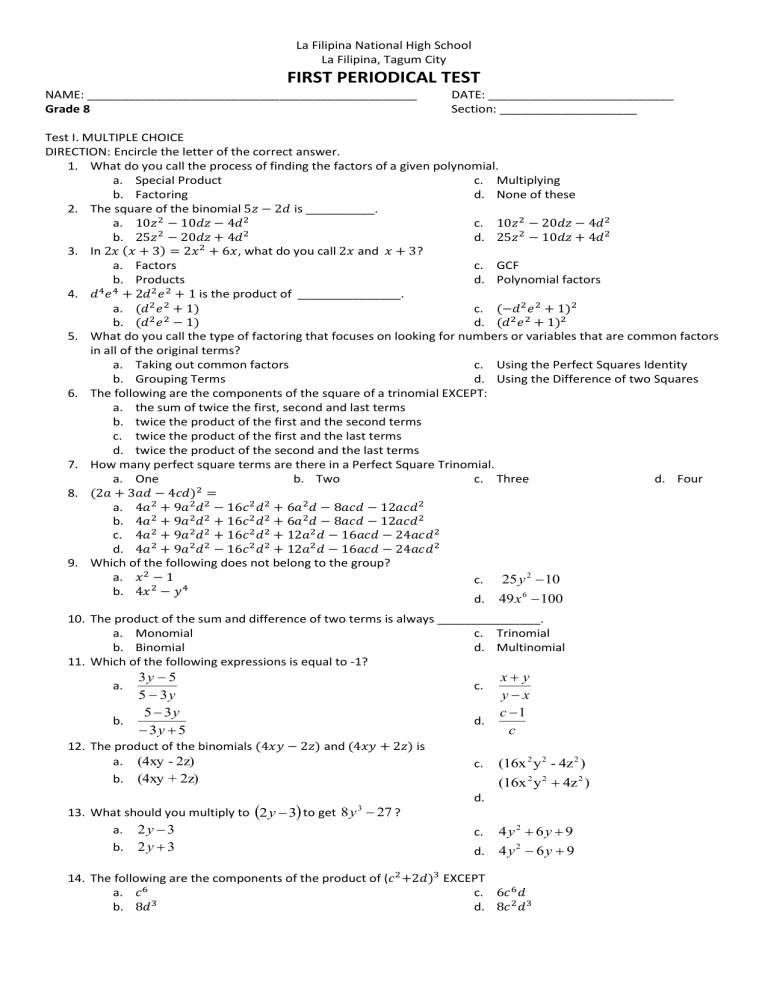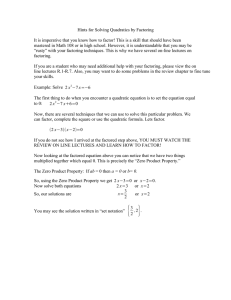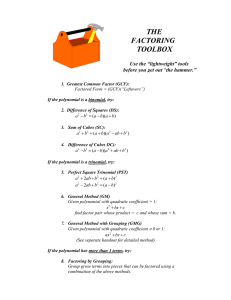Grade 8 Math Test: Factoring Polynomials & Algebraic Expressions
advertisement

La Filipina National High School La Filipina, Tagum City FIRST PERIODICAL TEST NAME: ________________________________________________ Grade 8 DATE: ___________________________ Section: ____________________ Test I. MULTIPLE CHOICE DIRECTION: Encircle the letter of the correct answer. 1. What do you call the process of finding the factors of a given polynomial. a. Special Product c. Multiplying b. Factoring d. None of these 2. The square of the binomial 5𝑧 − 2𝑑 is __________. a. 10𝑧 2 − 10𝑑𝑧 − 4𝑑2 c. 10𝑧 2 − 20𝑑𝑧 − 4𝑑2 2 2 b. 25𝑧 − 20𝑑𝑧 + 4𝑑 d. 25𝑧 2 − 10𝑑𝑧 + 4𝑑2 3. In 2𝑥 (𝑥 + 3) = 2𝑥 2 + 6𝑥, what do you call 2𝑥 and 𝑥 + 3? a. Factors c. GCF b. Products d. Polynomial factors 4 4 2 2 4. 𝑑 𝑒 + 2𝑑 𝑒 + 1 is the product of _______________. a. (𝑑2 𝑒 2 + 1) c. (−𝑑2 𝑒 2 + 1)2 2 2 b. (𝑑 𝑒 − 1) d. (𝑑2 𝑒 2 + 1)2 5. What do you call the type of factoring that focuses on looking for numbers or variables that are common factors in all of the original terms? a. Taking out common factors c. Using the Perfect Squares Identity b. Grouping Terms d. Using the Difference of two Squares 6. The following are the components of the square of a trinomial EXCEPT: a. the sum of twice the first, second and last terms b. twice the product of the first and the second terms c. twice the product of the first and the last terms d. twice the product of the second and the last terms 7. How many perfect square terms are there in a Perfect Square Trinomial. a. One b. Two c. Three d. Four 2 8. (2𝑎 + 3𝑎𝑑 − 4𝑐𝑑) = a. 4𝑎2 + 9𝑎2 𝑑2 − 16𝑐 2 𝑑2 + 6𝑎2 𝑑 − 8𝑎𝑐𝑑 − 12𝑎𝑐𝑑2 b. 4𝑎2 + 9𝑎2 𝑑2 + 16𝑐 2 𝑑2 + 6𝑎2 𝑑 − 8𝑎𝑐𝑑 − 12𝑎𝑐𝑑2 c. 4𝑎2 + 9𝑎2 𝑑2 + 16𝑐 2 𝑑2 + 12𝑎2 𝑑 − 16𝑎𝑐𝑑 − 24𝑎𝑐𝑑2 d. 4𝑎2 + 9𝑎2 𝑑2 − 16𝑐 2 𝑑2 + 12𝑎2 𝑑 − 16𝑎𝑐𝑑 − 24𝑎𝑐𝑑2 9. Which of the following does not belong to the group? a. 𝑥 2 − 1 c. 25 y 2 10 2 4 b. 4𝑥 − 𝑦 6 d. 49 x 100 10. The product of the sum and difference of two terms is always _______________. a. Monomial c. Trinomial b. Binomial d. Multinomial 11. Which of the following expressions is equal to -1? 3y 5 5 3y 5 3y b. 3y 5 x y yx c 1 d. c a. c. 12. The product of the binomials (4𝑥𝑦 − 2𝑧) and (4𝑥𝑦 + 2𝑧) is a. (4xy - 2z) b. (4xy + 2z) 13. What should you multiply to 2 y 3 to get 8 y 27 ? a. 2 y 3 b. 2 y 3 c. (16x 2 y 2 - 4z 2 ) (16x 2 y 2 4z 2 ) d. 3 c. 4y2 6y 9 d. 4y2 6y 9 14. The following are the components of the product of (𝑐 2 +2𝑑)3 EXCEPT a. 𝑐 6 c. 6𝑐 6 𝑑 3 b. 8𝑑 d. 8𝑐 2 𝑑3 15. Which of the following is NOT an example of a rational algebraic expression? a. b. c4 mm y2 y2 c. 5 a 25 d. None of these 16. 𝑥 6 𝑦 6 − 3𝑥 4 𝑦 4 + 3𝑥 2 𝑦 2 − 1 is the product of _____________ a. (𝑥 2 𝑦 2 − 1)3 c. (𝑥 2 𝑦 2 − 1)2 2 2 3 b. (𝑥 𝑦 + 1) d. (𝑥 2 𝑦 2 + 1)2 17. How do you check if the factors of an expression are correct? a. If the factors are added, then the sum of the factors is the given expression. b. If the factors are added, then the product of the factors is the given expression. c. If the factors are multiplied, then the product of the factors is the given expression. d. If the factors are multiplied, then the sum of the factors is the given expression. 18. (𝑥 − 𝑦)3 = ___________. a. 𝑥 3 − 3𝑥 2 𝑦 − 3𝑥𝑦 2 − 𝑦 3 c. 𝑥 2 + 3𝑥 2 𝑦 + 3𝑥𝑦 2 − 𝑦 2 3 2 2 3 b. 𝑥 − 3𝑥 𝑦 + 3𝑥𝑦 − 𝑦 d. 𝑥 2 − 3𝑥 2 𝑦 + 3𝑥𝑦 2 − 𝑦 2 19. How do you describe the relationship between multiplying and factoring a polynomial? a. Factoring is the reverse of multiplying. b. Factoring is the same with multiplying. c. Factoring and multiplying are not related. d. None of these 20. What is the factored form of 24𝑥 5 𝑦 6 𝑧 3 − 30𝑥 2 𝑦𝑧 4 ? a. (4𝑥 3 𝑦𝑧 3 )(6𝑥 2 𝑦 5 + 5𝑧) c. (6𝑥 2 𝑦𝑧 3 )(4𝑥 3 𝑦 5 − 5𝑧) 2 2 2 5 2 b. (6𝑥 𝑦𝑧 )(4𝑥 𝑦 − 5𝑧 ) d. (4𝑥 2 𝑦𝑧 3 )(6𝑥 3 𝑦 5 + 5𝑧) 2 21. If you multiply 2x 2x 1 , you get 2 x 4 x 2 . However, 2x 2x 1 is NOT the complete factorization for 2 x 4 x 2 . Why not? a. All factors are not prime. b. The factor x 1 is not prime. 2 c. A common factor can still be removed from the factor x 1 . d. A common factor can still be removed from the factor 2 x 2 . 22. What is the greatest common factor of 24𝑥 5 𝑦 6 𝑧 3 − 30𝑥 2 𝑦𝑧 4 ? a. (4𝑥 3 𝑦𝑧 3 ) c. (6𝑥 2 𝑦𝑧 3 ) d. (4𝑥 3 𝑦𝑧 2 ) b. (6𝑥 2 𝑦𝑧 2 ) 8 4 16 23. What is the greatest common factor in the expression 28 x y z 16 x 3 y 4 z 5 ? a. 8x3 y 4 z 5 b. 4 x 3 y 4 z 5 24. Which of the following does not belong to the group? 1 a. 4 𝑥 4 − 1 b. 𝑥 2 − 0.0001𝑦 4 25. What is the factored form of 27 x 3 512 y 3 ? a. 3x 8 y 9 x 2 24 xy 64 y 2 3x 8 y 9 x 2 24 xy 64 y 2 b. 26. Factor 𝑎2 𝑏 4 − 81. a. (𝑎𝑏 2 + 9)(𝑎𝑏 2 + 9) b. (𝑎𝑏 2 − 9)(𝑎𝑏 2 + 9) c. d. 8 x 4 y 4 z 3 c. (𝑥 + 1)4 − 4𝑥 6 d. 1.6(𝑥 − 1)2 − 49 c. d. 3x 5 y 2 3x 5 y3x 5 y 3x 8 y 9 x 2 24 xy 64 y 2 3x 8 y 9 x 2 24 xy 64 y 2 c. (𝑎𝑏 2 − 9)(𝑎𝑏 2 − 9) d. (𝑎𝑏 2 + 9)(𝑎𝑏 2 − 9) 27. What is the factored form 9 x 2 30 xy 25 y 2 ? a. 4x 4 y 4 z 3 c. 3x y3x 25 y 9x 5 y x 5 y b. d. 28. The following are the steps in getting the second factor of the difference of two cubes 𝑥 3 − 𝑦 3 , EXCEPT a. squaring the first term of the first factor b. adding the product of the first and second terms of the first factor c. adding the twice of the product of the first and second terms of the first factor d. Squaring the last term of the first factor. 2 29. What is the factored form of 4 x 4 x 3 ? a. 2 x 32 x 1 b. 2x 32x 1 c. 4x 3x 1 30. What are the factors of 8𝑥 3 − 27? a. (2𝑥 + 3)(4𝑥 2 − 6𝑥 + 9) b. (2x − 3)(4x 2 + 6x + 9) 31. What is the factored form of x 2 8 xy 7 y 2 a. d. 4x 3x 1 c. (2𝑥 + 3)(4𝑥 2 + 6𝑥 − 9) d. (2𝑥 − 3)(4𝑥 2 − 6𝑥 − 9) d. x y x 7 y a. x y x 7 y b. x y x 7 y c. x y x 7 y 32. The area of a square is 4𝑥 2 + 12𝑥 + 9 square units. Which expression represents the length of the side? a. (3x+2) units b. (2x+3) units c. (4x+9) units d. (4x+3) units 33. Suppose you have the following in your fruit bowl: x apples 6x mangoes 2 2x bananas 2 In all, you have 2 x 7 x pieces of fruit. What is the factored form of the expression? a. x2x 7 b. 2 x2 x 7 c. x 2 2 x 7 d. x 2 x 2 7 b. c. 34. To factor perfect square trinomials, you can use the following except? a. (First term)2 + 2(First term)(Last term) + (Last term)2 = (First term + Last term)2 b. (First term)2 - 2(First term)(Last term) + (Last term)2 = (First term - Last term)2 c. (First term)2 - 2(First term)(Last term) - (Last term)2 = (First term + Last term)2 d. NONE OF THE ABOVE 35. A town has exactly rectangular shape. If the town’s are is p 2 121 square kilometers, what is the length of the town border on each side of the rectangle it forms? a. p 11 and p 11 c. p 11 and p 11 d. None of these b. p 11 and p 11 36. Which of the following factors gives a product of 𝑥 2 + 5𝑥 + 4? a. (x + 1)(x + 4) b. (x + 2)(x + 2) c. (x + 5)(x– 1) d. (x + 2)2 37. When solving for the equivalent resistance of two circuits, we have to factor R 2 R R 1 . What is the factored form of the expression? a. R 1R 1 b. R 1R 1 c. R 1R 1 d. R 1R 1 38. Find the missing term: (𝑥 + ___)(3𝑥 + ___) = 3𝑥 2 + 27𝑥 + 24 a. 6, 4 b. 4, 6 c. 8, 3 d. 12, 2 2 39. The deflection of a beam of length L at a distance of 3 ft form its end is given by the expression 2 L 9 L 9 . What is the factored form of the expression? a. ( L 3)( 2 L 3) c. ( L 3)( 2 L 3) b. ( L 3)( 2 L 3) d. ( L 3)( 2 L 3) 40. Which of the following is a rational algebraic expression? 𝑥 c. 4𝑦 −2 + 𝑧 −3 a. √3𝑦 𝑎−𝑏 d. 𝑎+𝑏 3𝑐 −3 b. 0 √(𝑎+1) 41. A pretzel-maker fills identical bags with an equal number of pretzels. In one hour, the pretzel-maker bags 4k 2 17k 18 pretzels in all. How many numbers of bags (larger factor) does the pretzel-maker fill? a. 4k 9 c. 4k 2 b. 4k 6 d. 4k 18 𝑥 2 −1 42. What rational algebraic expression is the same as 𝑥+1 ? a. x + 1 b. x -1 c. 1 d. -1 43. The time t at which an object thrown upward at 12 m/sec will be 4 above he ground is given by the expression 5t 2 12t 4 . What is the factored form of the expression? a. (5t 2)(t 2) c. (5t 2)(t 2) b. (5t 2)(t 2) d. (5t 1)(t 4) 44. What will be the result when a and b are replaced by 2 and -1, respectively, in the expression (−5𝑎 – 2𝑏)(−2𝑎 – 3𝑏 2 )? 3 27 c. 7 a. 16 5 b. − 6 2 d. − 7 Test II. ESSAY (3 points each item) Direction: Answer each question in two (2) sentences. 1. When a student was directed to factor x 81 completely, his teacher did not give him a perfect score for 4 the answer ( x 2 9)( x 2 9) . The student argued that since his answer does indeed give x 81 when multiplied out, he should be given a perfect score. Was the teacher justified in her grading of this item? Explain. 4 ____________________________________________________________________________________________ ____________________________________________________________________________________________ ____________________________________________________________________________________________ ____________________________________________________________________________________________ ____________________________________________________________________________________________ ____________________________________________________________________________________________ ___________________________________________________________________________________________. 2. Is the expression x 2 x 2 5 y 2 x 2 5 in factored form? Explain. ____________________________________________________________________________________________ ____________________________________________________________________________________________ ____________________________________________________________________________________________ ____________________________________________________________________________________________ ____________________________________________________________________________________________ ____________________________________________________________________________________________ ___________________________________________________________________________________________. ANSWER KEY (First Grading Examination – Grade 8) 1. 2. 3. 4. 5. 6. 7. 8. 9. 10. 11. 12. 13. 14. 15. 16. 17. 18. 19. 20. 21. 22. B D A C B C D A B C C D B C B B C A C D A B





